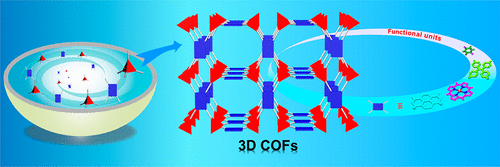当前位置:
X-MOL 学术
›
Acc. Chem. Res.
›
论文详情
Our official English website, www.x-mol.net, welcomes your
feedback! (Note: you will need to create a separate account there.)
Three-Dimensional Covalent Organic Frameworks: From Topology Design to Applications.
Accounts of Chemical Research ( IF 16.4 ) Pub Date : 2020-09-08 , DOI: 10.1021/acs.accounts.0c00357 Bo Gui 1 , Guiqing Lin 1 , Huimin Ding 1 , Chao Gao 1 , Arindam Mal 1 , Cheng Wang 1
Accounts of Chemical Research ( IF 16.4 ) Pub Date : 2020-09-08 , DOI: 10.1021/acs.accounts.0c00357 Bo Gui 1 , Guiqing Lin 1 , Huimin Ding 1 , Chao Gao 1 , Arindam Mal 1 , Cheng Wang 1
Affiliation

|
Covalent organic frameworks (COFs) represent a novel type of crystalline porous polymers with potential applications in many areas. Considering their covalent connectivity in different dimensions, COFs are classified as two-dimensional (2D) layered structures or three-dimensional (3D) networks. In particular, 3D COFs have gained increasing attention recently because of their remarkably large surface areas (>5000 m2/g), hierarchical nanopores and numerous open sites. However, it has been proven to be a major challenge to construct 3D COFs, as the main driving force for their synthesis comes from the formation of covalent bonds. In addition, there are several stones on the roads blocking the development of 3D COFs. First, the successful topology design strategies of 3D COFs have been limited to [4 + 2] or [4 + 3] condensation reactions of the tetrahedral molecules with linear or triangular building blocks in the first decade, which led to only three available topologies (ctn, bor, and dia) and strongly restricted the incorporation of some important functional units. Next, as it is very challenging to obtain large-size single crystals of 3D COFs and the same building blocks may yield many possible structures that are quite difficult to identify from simulations, their structure determination has been considered a major issue. Last, the building blocks utilized to synthesize 3D COFs are very limited, which further affects their functionalization and applications. Therefore, since it was first announced in 2007, research studies regarding 3D COFs have been underexplored for many years, and very few examples have been reported.
中文翻译:

三维共价有机框架:从拓扑设计到应用程序。
共价有机骨架(COF)代表了一种新型的结晶多孔聚合物,在许多领域都有潜在的应用。考虑到它们在不同维度上的共价连接性,将COF分为二维(2D)分层结构或三维(3D)网络。特别是3D COF由于其非常大的表面积(> 5000 m 2/ g),分层的纳米孔和众多开放站点。但是,事实证明,构建3D COF是一项重大挑战,因为合成3D COF的主要动力来自共价键的形成。此外,道路上还有几块石头阻碍3D COF的发展。首先,在最初的十年中,成功的3D COF拓扑设计策略仅限于四面体分子与线性或三角形结构单元的[4 + 2]或[4 + 3]缩合反应,这仅导致了三种可用的拓扑( ctn,bor和dia),并强烈限制了某些重要功能单元的合并。下一个,由于获得3D COF的大尺寸单晶非常具有挑战性,并且相同的构建基块可能会产生许多可能很难从模拟中识别出的结构,因此将其结构确定视为一个主要问题。最后,用于合成3D COF的构造块非常有限,这进一步影响了它们的功能和应用。因此,自从2007年首次宣布以来,有关3D COF的研究一直未得到充分研究,并且报道的例子很少。
更新日期:2020-10-21
中文翻译:

三维共价有机框架:从拓扑设计到应用程序。
共价有机骨架(COF)代表了一种新型的结晶多孔聚合物,在许多领域都有潜在的应用。考虑到它们在不同维度上的共价连接性,将COF分为二维(2D)分层结构或三维(3D)网络。特别是3D COF由于其非常大的表面积(> 5000 m 2/ g),分层的纳米孔和众多开放站点。但是,事实证明,构建3D COF是一项重大挑战,因为合成3D COF的主要动力来自共价键的形成。此外,道路上还有几块石头阻碍3D COF的发展。首先,在最初的十年中,成功的3D COF拓扑设计策略仅限于四面体分子与线性或三角形结构单元的[4 + 2]或[4 + 3]缩合反应,这仅导致了三种可用的拓扑( ctn,bor和dia),并强烈限制了某些重要功能单元的合并。下一个,由于获得3D COF的大尺寸单晶非常具有挑战性,并且相同的构建基块可能会产生许多可能很难从模拟中识别出的结构,因此将其结构确定视为一个主要问题。最后,用于合成3D COF的构造块非常有限,这进一步影响了它们的功能和应用。因此,自从2007年首次宣布以来,有关3D COF的研究一直未得到充分研究,并且报道的例子很少。









































 京公网安备 11010802027423号
京公网安备 11010802027423号